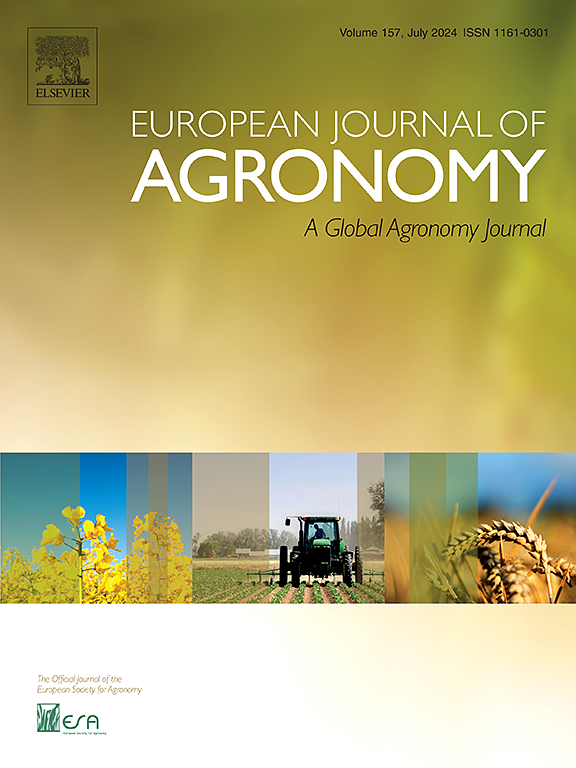Modeling the effects of agronomic factors and physiological and climatic parameters on the grain yield of hulled and hulless oat
IF 4.5
1区 农林科学
Q1 AGRONOMY
引用次数: 0
Abstract
Oat is a functional resource in food processing, medical, and cosmetic industries. The aim of this study was to compare the influence of agronomic factors and physiological and climatic parameters on the grain yield of hulled and hulless oat. The following variables were evaluated in a three-year experiment: (i) agronomic factors – nitrogen fertilization, plant protection, and oat morphotypes, (ii) environmental conditions – days after sowing, growing degree days, and accumulated precipitation until the achievement of vegetative, transition, and reproductive phases of plant growth and development, and (iii) physiological indicators of plant growth and development – net photosynthetic rate, transpiration rate, plant nitrogen status, leaf area index, and plant water potential. The physiological indicators of plant growth and development were similar in both oat morphotypes. Variability in morphological traits, yield components, and grain yield was affected mainly by the net photosynthetic rate in hulless oat and by the leaf area index in hulled oat. In both oat morphotypes, nitrogen fertilization was an agronomic factor that induced significant differences in yield, whereas the effects of plant protection were similar. A significant increase in yield was observed in response to the N rate of 60 kg ha−1, by 41 % in hulless oat and by 35 % in hulled oat. A further increase in the nitrogen rate to 120 kg ha−1 increased the grain yield by 11 % in hulless oat and by 13 % in hulled oat. In hulled and hulless oat, nitrogen use efficiency was determined at 20 and 15 kg of grain per 1 kg of N, respectively, and it contributed to a considerable difference in grain yield, which reached 5.8 Mg ha−1 in hulled oat and 4.2 Mg ha−1 in hulless oat. The modeled results indicate that plant height and yield components are the most important yield-related traits in oat cultivation, with significant potential for further improvement in performance.
模拟农艺因素、生理和气候参数对去壳燕麦和无壳燕麦谷物产量的影响
燕麦是食品加工、医疗和化妆品行业的一种功能性资源。本研究旨在比较农艺因素、生理和气候参数对有壳燕麦和无壳燕麦谷物产量的影响。在为期三年的实验中评估了以下变量:(i) 农艺因素--氮肥、植物保护和燕麦形态;(ii) 环境条件--播种后天数、生长度日和累计降水量,直至植物生长发育的营养期、过渡阶段和生殖阶段;(iii) 植物生长发育的生理指标--净光合速率、蒸腾速率、植物氮状况、叶面积指数和植物水势。两种燕麦形态的植物生长发育生理指标相似。无壳燕麦的形态特征、产量成分和谷物产量的变异主要受净光合速率的影响,而有壳燕麦则受叶面积指数的影响。在这两种燕麦形态中,氮肥是引起产量显著差异的一个农艺因素,而植物保护的影响相似。氮肥施用量为 60 千克/公顷时,无壳燕麦的产量明显增加了 41%,有壳燕麦的产量增加了 35%。氮肥用量进一步增加到 120 千克/公顷时,无壳燕麦的谷物产量增加了 11%,有壳燕麦增加了 13%。在有壳燕麦和无壳燕麦中,氮的利用效率分别为每 1 千克氮产生 20 千克和 15 千克谷物,这导致谷物产量的巨大差异,有壳燕麦的谷物产量达到 5.8 兆克/公顷,无壳燕麦的谷物产量达到 4.2 兆克/公顷。模型结果表明,植株高度和产量成分是燕麦种植中最重要的产量相关性状,具有进一步提高产量的巨大潜力。
本文章由计算机程序翻译,如有差异,请以英文原文为准。
求助全文
约1分钟内获得全文
求助全文
来源期刊

European Journal of Agronomy
农林科学-农艺学
CiteScore
8.30
自引率
7.70%
发文量
187
审稿时长
4.5 months
期刊介绍:
The European Journal of Agronomy, the official journal of the European Society for Agronomy, publishes original research papers reporting experimental and theoretical contributions to field-based agronomy and crop science. The journal will consider research at the field level for agricultural, horticultural and tree crops, that uses comprehensive and explanatory approaches. The EJA covers the following topics:
crop physiology
crop production and management including irrigation, fertilization and soil management
agroclimatology and modelling
plant-soil relationships
crop quality and post-harvest physiology
farming and cropping systems
agroecosystems and the environment
crop-weed interactions and management
organic farming
horticultural crops
papers from the European Society for Agronomy bi-annual meetings
In determining the suitability of submitted articles for publication, particular scrutiny is placed on the degree of novelty and significance of the research and the extent to which it adds to existing knowledge in agronomy.
 求助内容:
求助内容: 应助结果提醒方式:
应助结果提醒方式:


